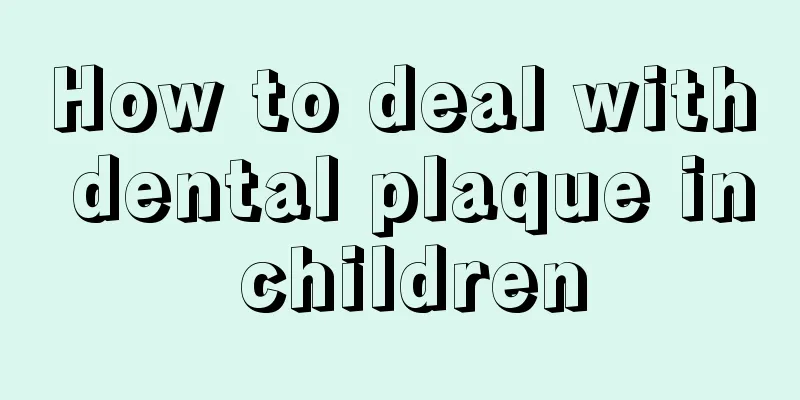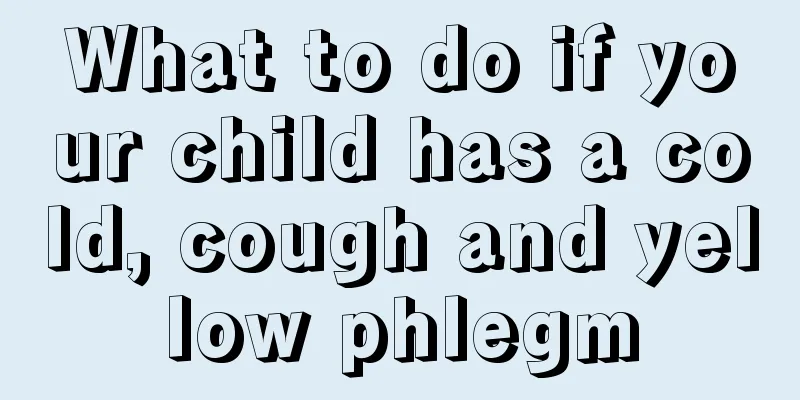How to deal with dental plaque in children

|
In life, many children cannot clean their mouths well because they have weak self-control and self-discipline. Moreover, children like to eat sweets very much, which causes a lot of dental plaque to appear on their teeth. As plaque continues to grow, tooth decay is likely to occur. So, is there any way to help children remove dental plaque? 1. How is dental plaque formed? Dental plaque is a bacterial film that is firmly attached to the tooth surface and is based on a sticky matrix. The toxins and other harmful substances produced by the bacteria in dental plaque directly stimulate the gums (commonly known as gums), causing inflammation of the tooth roots and forming gingivitis. Plaque will quickly reappear a few hours after being removed. If you do not brush your teeth, food debris will accumulate on your teeth for a long time, slowly forming thick, rough, visible soft plaque. After a long time, it will combine with minerals in the saliva, calcify and harden to form tartar. The surface of the tartar is easy to stick to plaque and is not easy to remove, thus causing gingivitis. Therefore, we must effectively remove dental plaque every day to effectively control caries and periodontal diseases and maintain oral health. 2. The reason why children have plaque on their teeth 1. Fluoride deficiency: Fluoride can strengthen the structure of teeth and bones, form a protective film on the surface of teeth, and inhibit bacteria. 2. Nutritional deficiency: Protein and calcium are the main substances that make up tooth enamel. When these substances are lacking, the tooth enamel will become rough and uneven, making it easy for food debris to remain, which is more conducive to the formation of dental plaque in children. 3. Gastrointestinal fire: Gastrointestinal fire is mainly manifested as bad breath. Excessive fire causes food gas to rise, providing a good breeding ground for the growth and reproduction of bacteria, making it easier for children to form dental plaque. 3. What should I do if my child has plaque on his teeth? 1. For children under two years old, mothers can put soft gauze on their fingers, dip them in clean water or light salt water, or even apply a little toothpaste, and gently scrub their little teeth after each meal. This not only cleans the mouth, but also helps the growth of teeth. 2. If your baby only has black spots on his teeth but the tooth surface is smooth without any defects, it may be pigmentation. Be careful not to eat too much food that can easily stain the teeth and pay attention to oral hygiene. 3. Educate children not to eat sweets, especially yogurt, before going to bed at night, and let them drink some boiled water after snacks, and go to bed after brushing their teeth and rinsing their mouths. 4. Brushing teeth is the most effective, most easily accepted and mastered method to remove plaque, prevent and control periodontal disease. Be sure to brush your teeth carefully, once in the morning and once in the evening every day. When brushing your teeth, pay special attention to the junction of the gums and teeth and the areas between the teeth where plaque is easily attached. Parents should cultivate their children's habit of brushing teeth, but when brushing their teeth, remember not to let the baby use adult toothpaste to avoid damaging the oral mucosa. When children are brushing their teeth, parents should be careful not to let them swallow toothpaste by accident. 5. Rinsing your mouth uses the impact force of liquid flowing in the mouth to remove retained food debris, but rinsing your mouth cannot remove dental plaque. You can choose mouthwash, which contains some medicinal ingredients that can reduce the formation of dental plaque and reduce the occurrence of caries and periodontal diseases. 6. Toothpick. When the gums recede and gaps (interdental spaces) appear between the teeth, use a toothpick to remove plaque from the adjacent surfaces of the teeth. The cross-section of toothpicks commonly sold on the market is circular. Since the interdental spaces are triangular, a toothpick with a triangular cross-section must be used to effectively remove dental plaque from the adjacent surfaces of teeth. 7. Pay attention to adjusting your child’s diet, maintain good eating habits, and ensure your child’s nutritional balance. You can give your children more vegetables, fruits and fresh sea fish. Conclusion: Dental plaque is constantly formed in the oral cavity, and new dental plaque will appear after cleaning the tooth surface. Therefore, we must develop the good habit of brushing our teeth in the morning and evening and rinsing our mouths after meals and maintain it throughout our lives, that is, we must constantly and thoroughly remove dental plaque throughout our lives. |
<<: What causes high intraocular pressure in children?
>>: How to use baby diaper pad?
Recommend
How tall is a child usually at birth?
The issue of height has always been a concern for...
Is height inherited from the father or the mother?
Nowadays, parents are more concerned about whose ...
How to treat hemolytic jaundice in infants
Recently, the smog documentary "Under the Do...
What to do if your child has sinusitis? Here are some ways to deal with it!
Sinusitis is a common disease, and children are m...
What is the common sense of caring for babies in the first three months?
The baby is relatively fragile in the first three...
How old can babies eat tofu?
Tofu is a very simple ingredient for us. It can b...
Obstructive jaundice, high urinary bile
Most newborns will have jaundice after birth. Und...
How to deal with a frightened child
When a child is born, he or she is curious about ...
What are the symptoms of precocious puberty in children?
Nowadays, more and more children are prone to pre...
6 effective sensory training methods for children with autism at home
Autism may be familiar to everyone now, and the n...
What are the complementary food recipes for one-year-old babies?
In life, if we want to maintain good health, we m...
Will drinking honey cause children to mature early?
Honey is not only nutritious but also easy to abs...
Causes and treatment of cerebral atrophy in children
Regarding the medical issue of brain atrophy, it ...
Seven truths about baby fever
1. Fever starts at 38 degrees Celsius When the ba...
What causes children to twitch while sleeping?
Parents should pay more attention to their childr...









